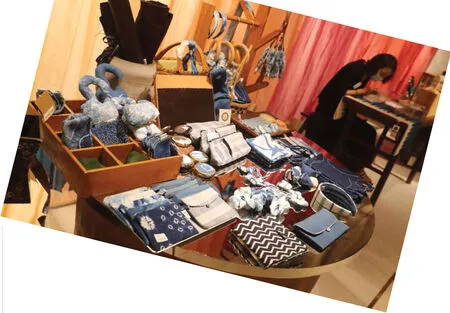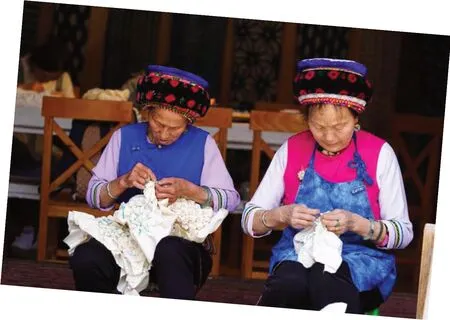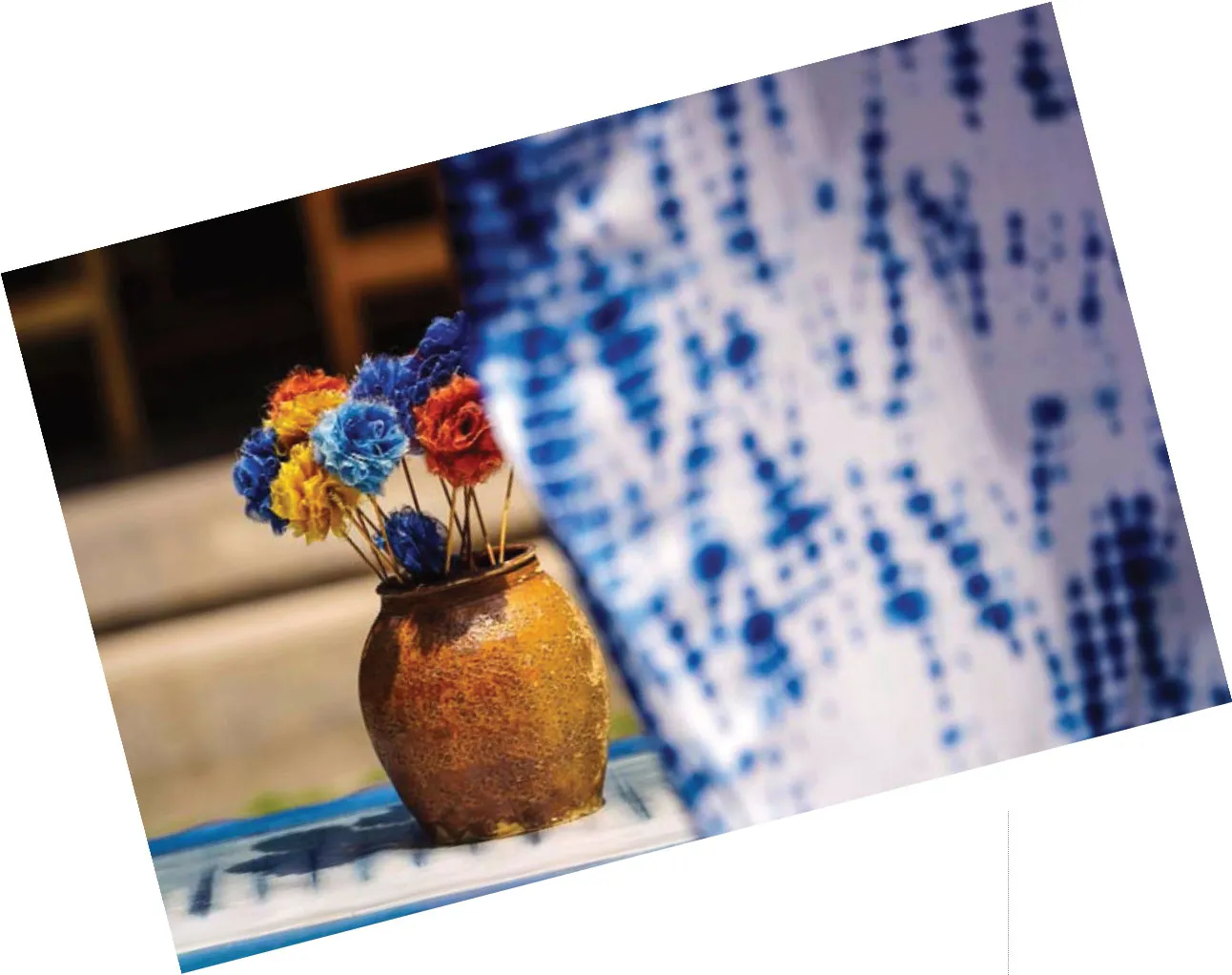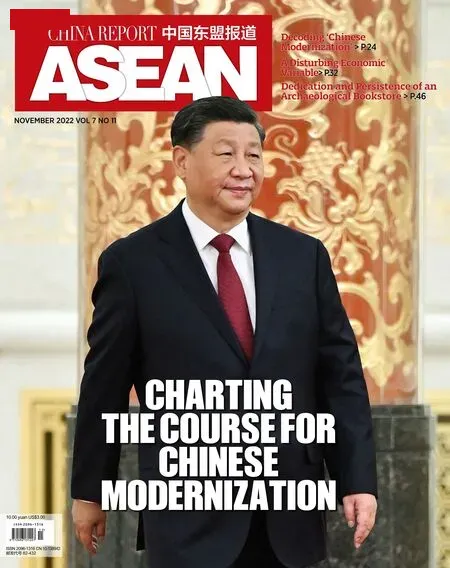A Colorful Rebirth
By Li Xiaoyang
Yunnan tie-dye technique comes back in style
Blue is the color of Dali,Yunnan Province: the sky,the clear waters of Erhai Lake and tie-dye works of art spanning almost every yard one passes by.Tie-dye,or Zaran in Chinese,is the timehonored handmade art of the local Bai ethnic group,rendering colors extracted from plants as patterns onto handwoven white cloth or a blended fabric of cotton and flax.The technique dates back over 1,000 years in China.
The actual dye is mainly made from indigo plants.To produce the dye,indigowoad leaves,which are blue,are gathered and fermented in a pit until they turn indigo in color.White cloth is then tied and sewn into different patterns by hand and subsequently dipped in dye.After the cloth is dried and rinsed,designs of butterflies,plum blossoms,fish,and so on,will“magically” appear,often producing stunning effects that painting cannot achieve.The Bai tiedye technique was listed as national intangible cultural heritage in 2006.
To hold on to tradition,Zhang Bin and Zhang Hanmin,a couple in their 30s,chose to quit their jobs in nongovernmental organizations in Beijing and return to their hometown.Both belong to the Bai ethnic group and were born and raised in Yunnan.In 2014,they set up a tie-dye workshop in Zhoucheng Village of Dali Bai Autonomous Prefecture,called Lanxu Eco-Culture Development Center.The name means“sustaining the color blue” in Chinese.The workshop is located in the old wood-framed house of Zhang Hanmin’s family.
Zhoucheng is well-known for the tie-dye skills of the Bai ethnic group,with its history of the craft going back to the late Ming Dynasty(1368-1644).The village now has around 300 artisans in the field.As Zhang Hanmin recalled,local women would hang their tie-dyes out to dry along the roadside when she was a child.But upon returning home six years ago,she realized very few young Bai people had upheld their traditions,with machine-made clothes outnumbering their handmade peers.That is why she and her husband decided to establish the workshop.The time had come to revive the technique.
“Tie-dye is a way of life that bears the customs and culture of the Bai people.By retaining the technique,we also hope to improve rural life,”Zhang Bin,co-founder of Lanxu,said.

Various tie-dye products at a fair in Kunming,Yunnan Province,August 5,2021.(VCG)
Blue Preservation
Over the past years,the couple have learned the traditional tie-dye techniques from their local seniors.They have also visited masters of the niche in other domestic regions,like Zhejiang and Sichuan provinces,improving their already acquired skills by gathering more information and different practices.

Two Bai women from Zhoucheng Village in Dali,Yunnan Province,create tie-dye products on April 13,2021. (VCG)

A tie-dye piece dries in a yard in Zhoucheng Village of Dali,Yunnan Province,on April 13,2021.(VCG)
At the very beginning of their bold undertaking,the couple set out to materialize the technique and expand the consumer base.It proved a lengthy process of trial and error.At that time,tie-dye creations by local people were sold only at low wholesale prices.Some of them doubted Lanxu’s products could ever be sold at higher retail prices.
By improving the production technique and product quality,the workshop gradually made a name for itself and started turning a profit.To meet modern demands,it expanded the variety of tie-dye products,ranging from clothes and accessories to curtains.Today,they have four stores in Dali.Many people from all over China travel to their workshop to have a go at tie-dyeing themselves,especially as Dali is becoming an increasingly popular travel destination.
Many of the workshop’s finished products feature snowflake and flower patterns.As Zhang Bin introduced,these patterns are designed by one of their senior masters of the craft.It symbolizes Dali’s natural scenery,where flowers blossom at the foot of the eternally snowcapped Cangshan Mountain.The snowflake pattern embodies local hopes of protecting the region from the impacts of global warming and retaining its natural beauty,right in line with Lanxu’s brand positioning.
“Aside from drawing dye from nature,tie-dye production processes,too,are environmentally friendly,requiring no chemical materials.We add alkaloid to the dye so that the dyed clothes can keep insects at bay,” Zhang Bin added.
According to him,they are continuously exploring the natural palette to create tie-dye works of more colors.So far,they have developed 18 different tones of blue as well as more than 50 materials to generate other colors,including tea,walnut skin,gardenia fruits and persimmon.The workshop has also teamed up with hotels and restaurants such as Yunhaiyao,a Yunnan cuisine restaurant chain,and its annual output had exceeded 4 million yuan (US$591,600) in recent years.
Like Lanxu,many similar tie-dye workshops are sprouting across Dali.The Puzhen tie-dye factory,also based in Zhoucheng,has even established a museum dedicated to the craft,and invited locals to participate in its curating process.The intangible heritage’s industrial chain is slowly but steadily taking shape.
Verve and élan
Besides turning the technique into profit,the couple have also been promoting it among the public.The workshop provides free classes for local children,during which they go pick plants on the mountains and create tie-dye products.According to Zhang Hanmin,it is like sowing a seed,which helps children understand they are inheritors of the Bai culture.
Since many inheritors of the technique are in their 70s and 80s today,Lanxu is also working on improving young people’s interest in tie-dye.“Many young locals leave their hometowns to work in other regions.To get them to return and support local development is a key issue,” Zhang Bin said.
The workshop also provides jobs for locals who once only relied on farm work for income.Around 50 local villagers now work for Lanxu,among whom many were born in the 1990s.
“Local residents even started helping us gather walnut skin after we developed the new dye skill,for which we would pay them an extra fee to expand their income sources,” Zhang Bin said.
To lift the undertaking to the next level,the couple is working on improving its products and promoting the brand.According to Zhang Bin,they have developed standards on dyeing times,temperatures as well as humidity,and are focusing on how to keep the colors from fading.
They also want to organize more educational tours and travel activities for urbanites and attract more young people to participate in the preservation of tie-dye.
Chinese Gen Zs today increasingly identify with the China Chic trend,the rise of native fashions,featuring indigenous elements and traditional culture.In the past,Lanxu’s class participants were mainly parents and children,but the past two years have seen a shift with many young people paying the workshop a visit.Youth are definitely taken with tie-dye,Zhang Bin concluded.

